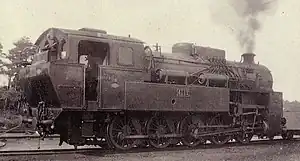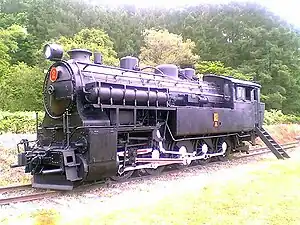| Class 4110 | |||||||||||
|---|---|---|---|---|---|---|---|---|---|---|---|
 | |||||||||||
| |||||||||||
| |||||||||||
| |||||||||||
| |||||||||||
The Class 4110 (4110形) is a class of 0-10-0 steam locomotives built by the Japanese Government Railways (JGR) and designed by Hideo Shima. A total of 39 locomotives were built by Kawasaki Shipyard (present-day Kawasaki Heavy Industries).
It was based on the 4100 type mechanism imported from the Kingdom of Bavaria at that time in 1912 (Meiji 45, Taisho era) and in terms of basic mechanism, it followed the same format.
It was a powerful steam locomotive and was operated in the steep sections of major trunk lines such as the Ou Main Line.
Five members of the class were converted to standard gauge and sent to Korea in 1939, four to the Pyeongbuk Railway and one to the Danpung Railway.[1] After the partition of Korea in 1945, all five locomotives were taken over by the Korean State Railway of North Korea, but their subsequent fate is unknown be it was assumed that they were scrapped around between 1969 and 1976. Some 4110s were sent to Taiwan during the occupation period. In 1945, all of them were classified as Taiwan Railways class EK900. None of them has preserved all of the EK900’s were scrapped between 1975 and 1980.
Preserved examples

One Class 4110 remains in preservation: 4122 in Ebetsu, Hokkaido.[2]
Gallery
 Type drawing of a JGR Class 4110 steam locomotive.
Type drawing of a JGR Class 4110 steam locomotive.
See also
References
- Steam Loco in Japan (Jokei Kikansha style book). Kigei Publishing Company. 1963.
- RM Pocket 6: 日本の蒸気機関車 [RM Pocket 6: Steam locomotives of Japan]. Neko Publishing Company. 1994.